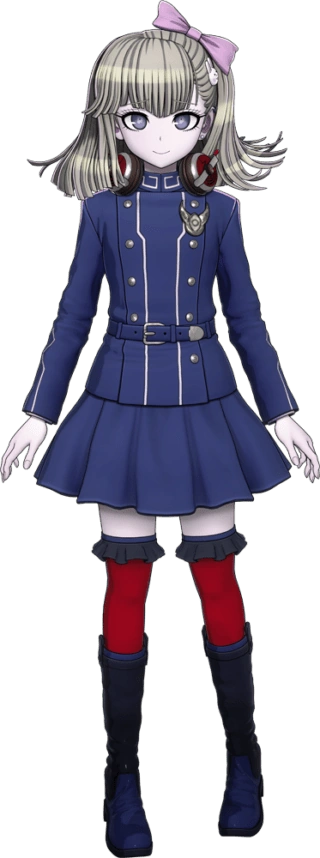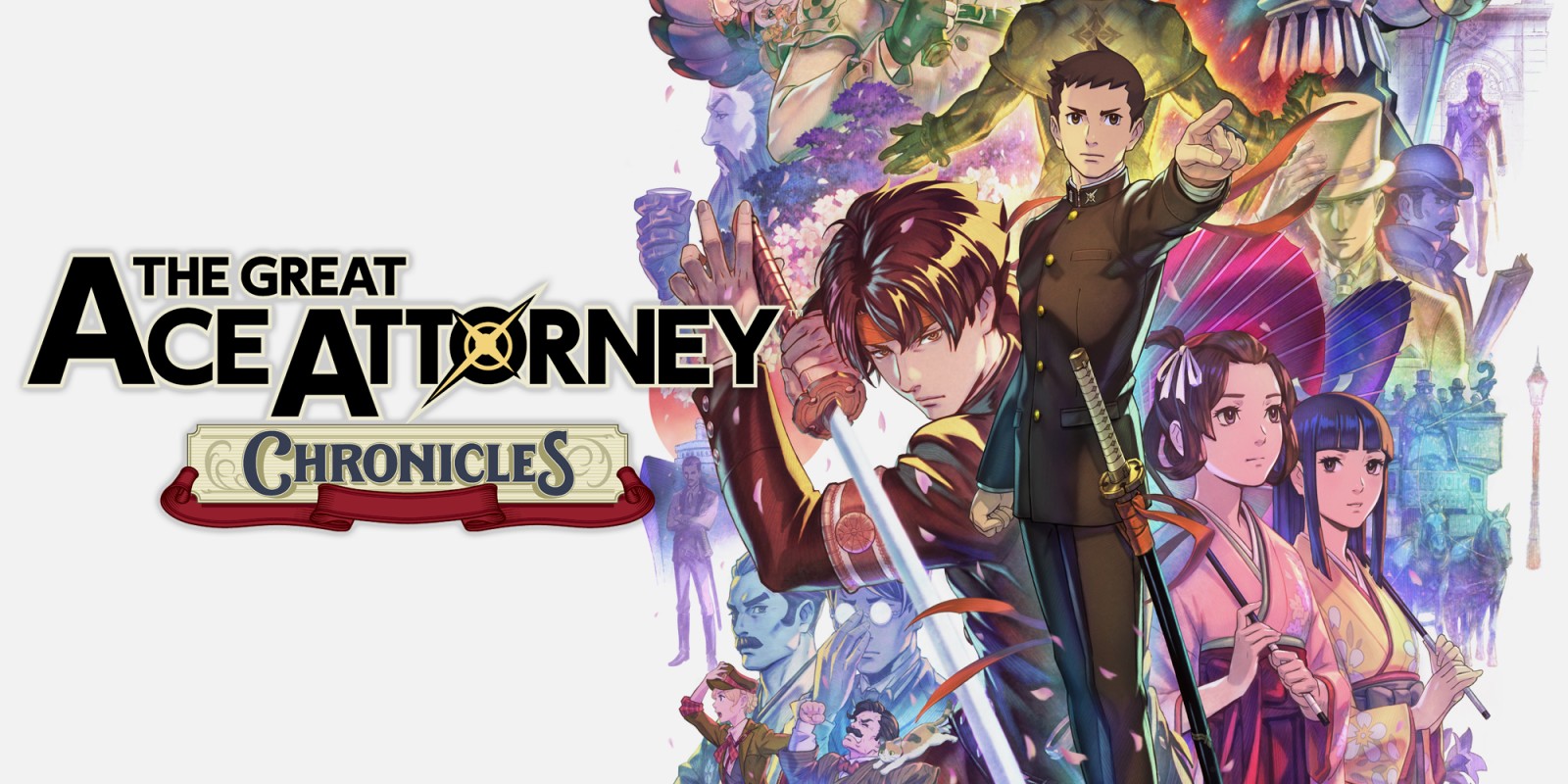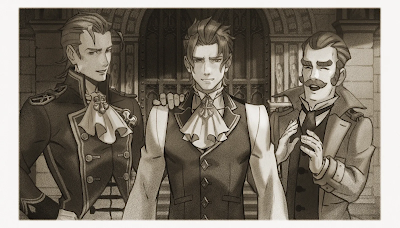I recently played and finished Master Detective Archives: RAIN CODE, a 2023 mystery solving puzzle game by Spike Chunsoft (the company also responsible for Danganronpa). In the game, we play as the amnesiac detective Yuma Kokohead on his journey to solve the hidden secret of Kanai Ward, an isolated community where it always rains. I won't go over the entire story, just specific parts that stuck out to me.
I have a lot of thoughts about the game, but my mind hasn't settled enough to call this a proper review. So I'm just going to go over a few of the things that stuck out to me. This article has spoilers for the entire game as well as Danganronpa V3.
The Old Switcheroo
The game's prologue wastes no time in introducing us to a colorful cast of characters - 5 Master Detectives with special powers for our main character to interact with, all of them with pretty elaborate designs and backstories. I won't go over them all, but Pucci Lavmin was a standout for me.
The Danganronpa games work on what I think is a pretty elegant system: The entire cast, except maybe a surprise reveal or two, is known from the start. This gives you plenty of time to interact with all the future murderers and victims before they actually become murderers and victims. Monokuma, who generally plays the part of the antagonist, is also known from the get-go. It's a great way to get invested in the characters and tends to make the later cases devastating - after all, you'll be seeing people you've hung around with for 15+ hours die.
So why am I bringing up Danganronpa again? Rain Code steps away from this system in favor of a 'revolving door cast.' Almost every case introduces a new location and a new cast of suspects, as well as a new Peacekeeper antagonist to sabotage the investigation. Additionally, you're accompanied by only one of your Master Detective companions per case, while the others take a back seat. This certainly keeps things fresh, but also makes it really hard to get invested into any character - it also means there's no room for characters to develop very much.
Compare and contrast with Ace Attorney. Ace Attorney also switches out its cast of suspects for each case, but quite importantly, it tends to stick with the same partner and prosecutor for multiple cases - and if a new prosecutor or partner gets swapped in, it's usually a familiar character that's been built up. It also generally keeps the same judge and detective. It provides the necessary stability to allow for a controlled amount of new characters and locations to enter the stage.
In this sense, Rain Code has the advantages of neither solution. The cast changes fundamentally for each case, yet we don't get the opportunity to get used to anyone but the main character and his partner Shinigami. As a result, there are a lot of characters that feel either completely pointless, or that feel like a waste of potential. To illustrate the undercooked nature of the former - the suspects in Chapter 1 aren't even named. They're called 'Priest,' 'Nun,' 'Church Servant' and 'Worshipper.' To illustrate the wasted potential of the latter - the suspects in Chapter 2 are named and relatively fleshed out, but 80% of the chapter's cast is dead by the end of it. If a character survives a chapter, the best you can expect is an optional sidequest afterward. And whichever Peacekeeper was antagonizing you also disappears, never to be shown again (or maybe in one or two cutscenes if you're lucky).
As a result, the problem from the very first case persists throughout much of the game, though it's more via screentime starvation than proper "deaths." On the subject of character deaths, there's something that bothers me about the way this game handles 'solving the case.'
Pointless Sacrifice
This is something Danganronpa and Rain Code share: When the murderer is caught and the case is solved, he or she dies. It adds a level of tension and tragedy to solving cases, especially if the murder is committed for sympathetic reasons. I don't dislike this idea conceptually, but let's explore the difference in execution (pun fully intended).
In Danganronpa, the mastermind in control of the game is also in control of the executions. The rules are pretty simple: Either you figure out who the murderer is and prove it in a trial, or you and all the other students get executed instead. You're under duress and not directly involved with the actual death of the culprit. While it's depressing to see a sympathetic murderer get executed in an ironic and humiliating fashion, all you did was prevent the deaths of all other students by revealing the truth. There isn't really any moral ambiguity to your own actions here.
In Rain Code, the situation is a lot more ambiguous. Your helper, Shinigami, lets you enter a metaphysical space - the Mystery Labyrynth - which you navigate by answering questions in various mystery solving mini-games. If you conquer the Labyrinth by figuring out who the true culprit is, Shinigami destroys the Labyrinth by reaping the culprit's soul. The exact mechanics of this are unclear, but the game puts it simply: This kills them. I'd be happy to leave it at that, but the game's finale raises a lot of questions about this. But for now, let's put a pin in it and go back to the 'reaping problem' when it's relevant.
There's a lot that bothers me about the concept of Mystery Labyrinths. The idea is that this Labyrinth represents the unsolved mystery as it exists in the real world. By choosing to enter it, you sign an unspoken agreement to either catch and kill the culprit or to be absorbed by the labyrinth, leading to your own death. It's also implied by Shinigami that not resolving the Labyrinth could let it affect the real world eventually, though this isn't ever really shown or elaborated on. The game clearly tries to put pressure on solving the case like Danganronpa does, but it's a lot harder to swallow because it's pretty unclear what the rules are, who or what enforces them, and why. To contrast, in Danganronpa, it's understood that a sadistic mastermind is imposing these rules on you to serve the 'killing game.'
To further confuse the issue, what happens in the Mystery Labyrinth "stays" there. Even though the Labyrinth supposedly represents the mystery in the real world, Only Yuma and Shinigami even remember that the case was solved after it's destroyed. The culprit simply dies on the spot, and Yuma usually still ends up standing there at the firing end of the Peacekeepers' guns, sputtering and mumbling before being saved by the random appearance of a companion - or by Shinigami possessing the corpse of the culprit and awkwardly "confessing" to the murder (I will admit that the first time this happened, the delivery of the lines made me laugh out loud). It feels a lot more awkward and less clean than revealing the murderer in a closed circle of suspects and witnesses, so no one has any doubts. The Mystery Labyrinth doesn't feel like a tool for finding the truth - because it doesn't - it's a tool for killing the culprit. Finding the truth is secondary and is awkwardly handled after the fact with no evidence or debate.
While I think it's hard to argue with the awkwardkness, you could offer a counterpoint and say that the game is aware of the moral ambiguity. The main character is depicted as very conflicted about essentially committing "murder." The game casts doubt on his actions, and in so doing, also casts doubt on the player's actions. But because the mechanics of the Labyrinth and reaping aren't explained very well, not to mention the fact that you don't really have a choice if you want to keep playing the game, it almost makes it worse. I firmly believe that if you're asking a character or person to make a choice, he or she should have the necessary cards to make an informed decision. And in this case, you just don't.
Morality aside, the problem about the nature of the Labyrinth I mentioned earlier continues to rear its ugly head. If conquering the Labyrinth - the representation of the mystery in the real world - destroys it, but the mystery is actually still unsolved anywhere but in Yuma's head, then what's the actual point of destroying the labyrinth? What does that actually do? The game demonstrates no way in which the Mystery Labyrinth affects the real world at all, aside from the aforementioned killing. But the reverse is not entirely true; things get more confusing during the finale: Yuma decides not to 'reap' the "culprit," lets him go with the promise that he'll reveal the truth and thus destroy the Labyrinth from the outside. It's all but spelled out that this actually works, so why doesn't the inverse work? Why did we have to kill so many culprits, including sympathetic ones, because we're stuck in an arbitrary 'kill or be killed' scenario without any clear insight on the rhyme and reason?
I'm willing to accept that I might be missing something here, but it'd take a pretty solid explanation to convince me. Please do let me know.
If you thought we'd reached the worst part of how pointless character deaths end up being in this game, just wait until we get to the finale and the big twist.
Homunculus Narrative
In the finale, the characters end up in a mysterious abandoned part of town... inhabited by zombie-like people. I'll give one more warning in case you've become interested in playing the game yourself - this is where the game puts all its cards on the table.
You encounter the "undead" versions of people you've personally "reaped." I was thinking initially that the game was going to use this haunting visual to confront the main character with his "decisions," but it took it in a different and arguably even worse direction.
Every person who lives in the isolated Kanai Ward is a cloned homunculus created by the Amaterasu Corporation. And not only are they homunculi, they are 'immortal' - if they die, they are simply resurrected a day later. But then, they are defective homunculi, so their revival causes them to lose their intelligence and memories. The degree of this loss varies individually, with some of them able to carry conversations, while others are essentially cannibalistic zombies. They're all kept in an abandoned corner of Kanai Ward where they can safely shamble around without harming anyone.
On the one hand, I think this is a pretty cool twist. The idea that the corpses resurrect and that the inhabitants of Kanai Ward aren't quite human is subtly built up throughout the story - I don't actually think it's a bad inclusion when taken on its own. But in the larger story, it creates a massive disconnect with Shinigami and the Mystery Labyrinth. I mentioned earlier that Shinigami's 'reaping' was going to cause massive problems later, and this is where the 'reaping problem' finally comes in.
What we see in the Mystery Labyrinth is Shinigami quite literally attacking and presumably destroying the culprits' souls in a supernatural ritual. This leads to their death, but one assumes it'd be a lot more thorough and final than just a conventional killing. However, because the culprits were all Homonculi, they just come back after being reaped - and some of them are pretty coherent at that. They're clearly damaged, but it's hard to say if they've lost their "soul."
So the question has to be asked again: What does reaping actually do? Is it, for all the dramatic presentation, just Shinigami killing them, with the soul being a symbolic representation? And why does this supernatural ritual not work properly on Homunculi? Why is Shinigami not aware that the soul she's reaping belongs to someone that isn't human? Could a "resurrected" Homonculus theoretically be Reaped again in the Mystery Labyrinth? Basically, this is a twist that breaks the already fragile established rules over the Mystery Labyrinth. Again.
While all these questions frustrated me, I admit I was a little elated as well. If the victims and murderers were still around in some form, that could create a really interesting situation. Some of the sacrifices I felt were unneeded could be undone. However, this is where the game double dips - it wants the twist of having all the deaths be "undone" while still keeping the emotional weight of a death. To illustrate this: Yuma has a final interaction with his deceased-but-resurrected boss, Yakou. He wants to follow him when he shambles away but is told to move on "from the dead." But... he's not dead. He's immortal. He just has some kind of brain damage from his resurrection. In a normal situation, it's vital for the process of grieving that you move on, but the fact is that he just isn't really dead. The situation isn't final at all and it bothers me that the game pretends it is. This twist could only work if you adhered to the following:
- The resurrected Homonculi are truly mindless and there's not a fragment of the former person left.
But it doesn't. You have conversations with the resurrected Homunculi, some more coherent than others. There's also a very emotional scene between a victim and her friend that frustratingly happens off-screen, but this implies the resurrected Homunculi are still capable of both thought and emotion. It follows, then, that if they are biologically alive and maintain parts of their selves, they're simply not dead in the way the game wants you to think of them as.
To put the icing on this frustrating cake, the game then proceeds to never acknowledge the resurrected Homunculi again after the final Mystery Labyrinth begins. In the game's closing stages, the inhabitants of Kanai Ward know they are Homonculi. Their leader is helping them figure out ways to live normal lives. But the resurrected ones just aren't acknowledged. You'd think Amaterasu Corp would invest in finding ways to restore their cognitive abilities and memories at least to some extent - it'd be insane to just have a corner of the city filled with mindless (and not so mindless) zombies now that the secret is out. However, it seems acknowledging this gaping hole in the story would cheapen the deaths so they just gloss over it.
All this just leaves me feeling very conflicted and unsatisfied about the way each case turned out.
Concluding for Now
I realized as I was writing this article that I have way too many thoughts for a single coherent article. I'm not even sure if this article is particularly coherent. But the bottom line is that the game's story has some frustrating patterns: It introduces and then dismisses characters at such a rapid pace that you can barely get attached to anyone at all. Further, it makes a big deal of us "killing the culprits" without explaining it very well, to then undo the "killing," to then try and pretend it hasn't been undone because reasons. It's a game where the supernatural Mystery Labyrinth is at war with the sci-fi intrigue of Kanai Ward and it can never reach a satisfying resolution.
I have a lot more to say about the game, but I think I should make a different article about that, since this issue is the one that bothered me the most. In spite of that, though, I actually had a good time with the game. The individual cases, mysteries and characters are good. In fact, I wouldn't even care that characters were introduced and dismissed so quickly if I didn't care about them - it's just a waste of potential in my opinion.
Hopefully my next article will be a bit more positive. Thanks for reading and do let me know if I made any errors. I'm happy to be wrong if it means clearing up my frustration.












.jpg)
.jpg)
.jpg)
.jpg)
.jpg)
.jpg)






















